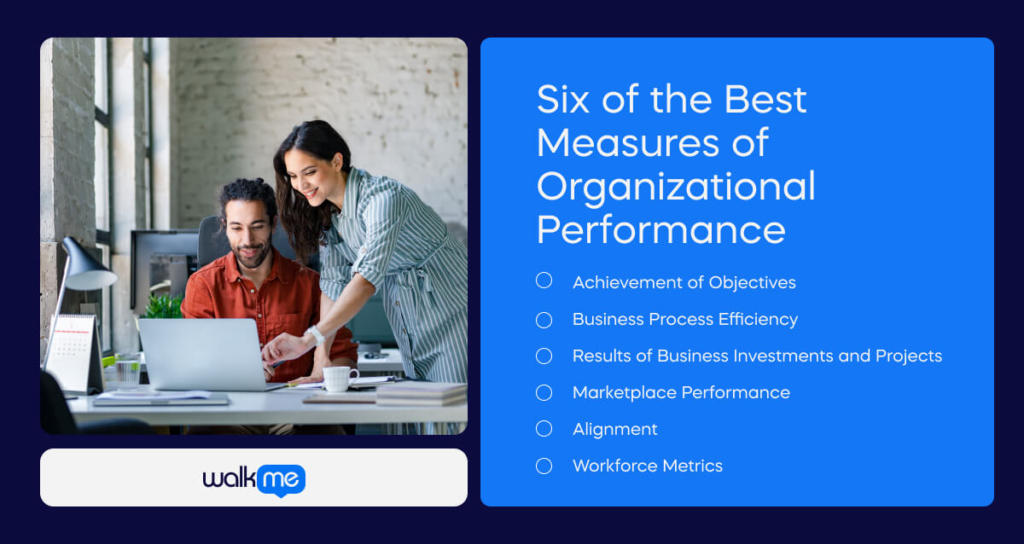How do you measure organizational performance for businesses? The answer is simple: it depends.
One business performs well when it has a sustainable profit margin. For another, outstanding performance means their staff training is better than it was. And for another, only the stock price makes any difference.
This is just a small sample of business targets. There are hundreds of measures of organizational performance out there. It’s no joke. Researchers have identified hundreds of performance measures across some business sectors.
Effective change management requires careful consideration of the available measures and how they will help you achieve your business objectives. Organizational development professionals need to be able to analyze and interpret different performance indicators and understand how they can be used to drive strategic initiatives.
There’s good news. We’ve done the hard work for you. This article will make sense in measuring organizational performance, one step at a time. The article explains why organizational performance is essential and how it works. We’ll then examine six key measures that could work for your business.
By the way, there are many specialist words that people use to talk about organizational performance. If you’re confused, just check out the glossary at the bottom of the article.
Why Is Measuring Organizational Performance Important?
Measuring organizational performance is an essential part of strategic decision-making. Understanding organizational performance helps leaders at every level to set targets, track their impact, and provide accountability to stakeholders.
However, as we have described, the precise meaning of organizational performance will change from business to business. Companies may focus on financial performance, growth, and customer measures or use multiple measures to understand their outcomes.
Whatever information you gather about performance needs to be useful for the company’s future. That’s why choosing good performance measures is essential. The right measures provide insight into strategic management. The wrong actions will be a waste of time.
Measuring Organizational Performance At Different Levels
A good understanding of performance must take information from every company level.
From year to year, some measures will be more critical. One year, it may be essential to see improved sales performance. In the next, customer satisfaction may be the key driver of success. And in another one, shareholders may want to see better profits for the company.
By measuring performance at multiple levels, organizations clearly understand their current operations. With multi-level performance measurement, leaders can see all their strengths and weaknesses across business units.
As this is an essential tool for strategic decision-making, we will explain how measures at different levels are necessary.
Individual Level Performance

Measuring individual performance shows how employees are contributing to the organization’s success. Organizations can provide feedback and coaching for improvement by capturing individual performance and making informed decisions about promotions, incentives, and other rewards.
Some individual performance measures include task performance, contextual performance, adaptive performance, and counterproductive work.
- Task performance refers to an employee’s ability to effectively, efficiently, and accurately complete tasks. This dimension can be measured using objective criteria, including the number of tasks completed, quality of work, timeliness, and accuracy.
- Contextual performance encompasses actions beyond an employee’s formal job description, such as helping others, actively participating in meetings, or supporting the organization’s values. This dimension can be assessed through employee feedback, peer evaluations, or observations by supervisors.
- Adaptive performance measures employees’ ability to adjust and respond effectively to new and unexpected situations. This can be measured using problem-solving skills, creativity, learning agility, and working well under pressure.
- Counterproductive work behaviors such as absenteeism, theft, or substance abuse hinder an employee’s performance. This dimension can be measured using attendance records, incident reports, or other objective criteria.
Team-Level Performance
Measuring team performance takes the pressure off individuals. With team performance, we want to know how people can be organized to maximize their resources.
There’s a variety of measures we can take to understand team performance. Team adaptability refers to the team’s ability to adjust to changing situations. Team orientation measures how well team members collaborate. Leadership measures the effectiveness of the team leader. Back-up behaviors measure how well team members support each other.
In many cases, qualitative assessments are also important for measuring team performance. These assessments involve gathering data through interviews, focus groups, and observations to understand the team’s performance from multiple perspectives. Further analysis could use the IPO model to measure a team’s performance based on its inputs, processes, and outputs.
Organization-Level Performance
Leaders need to look at many different parts of the business to measure how well a company is doing. This includes things like how they treat their workers, how they plan for the future, and how they understand their customers. It’s essential to measure all these things through subjective or objective measures. It’s vital to ensure they match the company’s goals.
Six of the Best Measures of Organizational Performance

So here’s an apology. This article can’t tell precisely what metrics are best for your company. Your location, size, and operations will make a difference, as well as many other factors.
But here, we will offer a small number of often valuable metrics. They work well in many contexts – and there’s a good chance they will work for your business.
Achievement of Objectives
Strategically managed organizations plan specific goals regularly. Monitoring the results of those goals is a simple but effective measure of organizational performance.
Depending on the goals set, this approach might evaluate the achievement of objectives in expenditure, bottom-line profits, innovation, or growth. Indeed, some models of organizational effectiveness revolve exclusively around goal-setting and achievement.
Business Process Efficiency
Are your business processes working well? Understanding the efficiency of business processes gives a deep but focused view of organizational effectiveness. Business processes, units, and functions may be measured by speed, cost-efficiency, results, or perceived agility. Leaders can use subjective and objective measures to can find growth opportunities.
Results of Business Investments and Projects
Monitoring the outcomes of business projects gives a higher-level measure of organizational performance. High-level metrics for evaluating individual projects can include:
- Financial returns
- Project results
- Project efficiency
- Projected costs versus actual costs, measured against the derived benefits
Some projects will be practical, others redundant. Working on measuring these outcomes can help you show which is which.
Marketplace Performance
Business performance can be measured by looking outside the organization itself. After all, a profitable business may be underperforming compared to its competitors. When leaders analyze the marketplace, they can better understand their organizational strengths.
Marketplace performance measures may involve an inspection of market share, innovation, valuation, size, and profits.
Alignment
Strong organizational alignment means all company parts work together towards the same goals. It means that everyone in the company understands its mission and objectives and that they are all working together in a coordinated way to achieve them.
Organizational alignment can include the relations between:
- Different departments
- Individual employees and their department or their team
- The workforce’s actions and the organization’s mission
- The organization’s behavior and mission
- An organization and its marketplace
The more aligned workers and business units are with the organization, the better the organization will perform.
Workforce Metrics
The workplace and the workforce experiences play major roles in how well an organization performs.
Skilled, motivated employees are more engaged, productive, and profitable. To understand how the employee experience affects organizational performance, a business should focus on measurements such as
- Skills and proficiency
- Productivity and performance
- Engagement and motivation
- Sentiment
- Retention and loyalty
These can offer insight into strengths, weaknesses, and opportunities for improvement.
The Future of Organizational Performance
Measuring organizational performance is important for setting targets, tracking their impact, and providing accountability to stakeholders. But with hundreds of measures, choosing the right ones is difficult. Moreover, measuring organizational performance is essential and comes with many risks and benefits.
The measures we’ve discussed are just a starting point. To get to grips with the topic, you must dive into your business area and keep up with the latest developments. For example, a 2023 McKinsey blog suggested that resilience could be an important measure for the future.
No business can predict the future, but every business can use its present strengths to prepare for the challenges of the future. Measures of organizational performance are one great tool for this.

